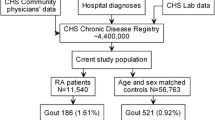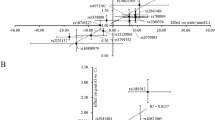Summary
In this study we examined 22 Hungarian male probands with gout and 105 of their first degree relatives. This was the first family study in Hungary in which the characteristics of distribution of gout and hyperuricaemia among patients with gout and their first degree relatives, as well as the possible correlation between the prevalence of the disease and MHC class I antigens was investigated. Our gout patients showed the following characteristics: (1) There was a typical onset after age 40, benign oligoarticular form of arthritis, underexcretion of uric acid, moderate hypertension without evidence of reduced renal function, and a relatively high frequency of hyperostosis. (2) The prevalence of hyperuricaemia and gout exceeded the general population level in the first degree relatives of our gout patients. (3) The distribution of MHC class I antigens among the first degree relatives of our patients with gout showed no characteristic patterns. (4) There was no correlation between HLA B27 antigens and prevalence of gout or hypeostosis in family sibling studies. (5) The high frequency of gout and hyperuricaemia, as well as the lack of characteristic HLA patterns among the first degree relatives of gout patients in our family studies, point to the possible cumulative effect of several genes and environmental factors in the etiopathogenesis of this disease.
Similar content being viewed by others
References
Scudamore C (1819) A treatise on the nature and cure of gout and rheumatism, 3rd edn. London
Smith CJ, Cotterman CW, Freyberg RH (1948) The genetics of gout and hyperuricaemia. An analysis of nineteen families. J Clin Invest 27:249–759
Stecher RM, Hersh AH, Solomon WM (1949) The heredity of gout and its relationship to familial hyperuricaemia. Ann Intern Med 31:595–598
Hauge M, Harvald B (1952) Heredity in gout and hyperuricaemia. Acta Med Scand 152:247–257
Duncan H, Dixon A (1960) Gout, familial hyperuricaemia, and renal disease. Q J Med 29:127–135
Rakic MT, Valkenburg HA, Ruth T, Davidson RT, Engels JP, Mikkelsen WM, Neel JV, Duff IF (1964) Observations on the natural history of hyperuricaemia and gout. Am J Med 37:862–871
Talbott JH, Coombs FS (1938) Concentration of serum uric acid in non-affected members of gouty families. J Clin Invest 17:508–511
Massari PU (1980) Familial hyperuricaemia and renal disease. Arch Intern Med 140:680–684
Kelley WN, Green ML, Rosenbloom FM, Hendersen JF, Seegmiller JE (1969) HGPRT deficiency in gout. Ann Intern Med 70:155–206
Segmiller JE (1980) Human aberrations of purine metabolism and their significance for rheumatology. Ann Rheum Dis 39:503–517
Kellgren JH (1964) Heberden Oration 1963: The epidemiology of rheumatic diseases. Ann Rheum Dis 22:109–122
Rondier J, Wood PHN (1968) Distribution of gout and serum uric acid levels in the relatives of probands with gout. Ann Rheum Dis 27:287
Grahame R, Scott JT (1970) Clinical survey of 354 patients with gout. Ann Rheum Dis 29:461–468
Noel JV (1941) The clinical detection of the genetic carriers of inherited disease. Medicine 26:115–153
Talbott JH, Yü TF (1976) Gout and uric acid metabolism. Thieme, Stuttgart, p 27
Yü TF (1984) Diversity of clinical features in gouty arthritis. Semin Arthritis Rheum 13:360–368
Hollingworth P, Scott JT (1983) Familial gout, hyperuricaemia and renal impairment. Ann Rheum Dis 42 [Suppl]:87–88
Dieppe PA (1991) Investigation and management of gout in young and elderly. Ann Rheum Dis 50:263–266
McCarty DJ, Hollanden JL (1961) Identification of urate crystals in gouty synovial fluid. Ann Intern Med 56:711–737
Agudelo CA, Weinberger A, Schumacher HR, Turner R, Molina J (1979) Definitive diagnosis of gout by identification of urate crystals in asymptomatic metatarsophalangeal joints. Arthritis Rheum 22:559–561
Gibson T, Highton J, Simmonds HA, Potter CF (1979) Hypertension, renal function and gout. Postgrad Med J 55 [Suppl]: 21–25
Barham D, Trinder P (1972) An improved color reagent for the determination of blood glucose by the oxidase system. Analyst 97:142–145
Rood JJ van, Leeuwen A van, Keuning SS, Ond AB van (1975) The serological recognition of the human MLC determinants using modified cytotoxicity technique. Tissue Antigens 5:73–79
Mituszova M, Judak A, Poor GY (1989) Hyperuricaemia and gout (in Russian). Rheumatologia 2:26–30
Cameron JS, Simmonds HA (1981) Uric acid, gout and kidney. J Clin Pathol 34:1245–1254
Seegmiller JE, Rosenbloom EM, Kelley WN (1967) An enyzme defect associated with sex-linked neurological disorders and excessive purine synthesis. Science 155:561–567
Fox IH, Kelley WN (1971) Phosphoribosylpyrophosphate in man: biochemical and clinical significance. Ann Intern Med 74:424–433
Kelley WN, Fox IH, Palella TD (1989) Gout and related disorders of purine metabolism. In: Kelley WN, Harris ED, Rudy S, Sledge CB (eds) Textbood of rheumatology, 3rd edn. Saunders, Philadelphia, pp 1395–1448
Seegmiller JE, Dixon RM, Kemp GI, Angus PW, McAlindon TE, Dieppe P (1990) Fructose induced aberration of metabolism in familial gout identified by 31P magnetic resonance spectroscopy. Proc Natl Acad Sci USA 87:8326–8330
Calabrese G, Simmonds HA, Cameron JS, Davies PM (1990) Precocious familial gout with reduced fractional urate clearence and normal purine enzymes. Q J Med 75:441–450
Schumacher TM, Genant HK, Kellet MS, Mall SC, Fye KH (1978) HLA B27 associated arthropathies. Diagn Radiol 126:289–297
Brewerton DA (1975) The histocompatibility antigen (HLA B27) and disease. Semin Arthritis Rheum 4:191–195
Mituszova M, Judak A, Poor GY, Gyodi E, Stenszky V (1991) Investigating HLA ABC antigens in gout. Magy Rheum 32:11–18
Shapiro RF, Wiesner KB, Brian BL, Utsinger PD, Resnick D, Castles JJ (1976) The association of HLA B27 with Forestier's disease (vertebral ankylosing hyperostosis). J Rheumatol 3:4–8
Littlejohn GO, Hall S (1982) Diffuse idiopathic skeletal hyperostosis and new bone formation in male gouty subjects. Rheumatol Int 2:83–86
Hall AP, Barry PE, Dawber TR, McNamara PM (1967) Epidemiology of gout and hyperuricaemia. A long term population study. Am J Med 42:27–37
Morton NE (1979) Genetics of hyperuricaemia in families with gout. Am J Med Genet 4:103–106
Author information
Authors and Affiliations
Rights and permissions
About this article
Cite this article
Mituszova, M., Judák, A., Poór, G. et al. Clinical and family studies in Hungarian patients with gout. Rheumatol Int 12, 165–168 (1992). https://doi.org/10.1007/BF00302147
Received:
Accepted:
Issue Date:
DOI: https://doi.org/10.1007/BF00302147




